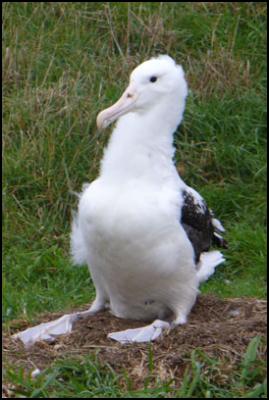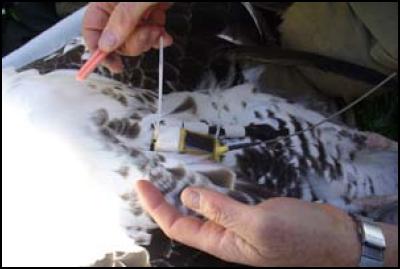Mystery of the albatross may soon be solved
Monday, October 15, 2007
Mystery of the
albatross may soon be
solved

The mystery of where juvenile albatrosses fly to after leaving New Zealand may soon be solved, with satellite tracking devices now successfully showing the progress of two males and one female hatched at Taiaroa Heads, Otago, this season. The tracking of the majestic seabirds for the next four years is a collaboration between the University’s Bindi Thomas, who is undertaking a PhD study into the efficacy of satellite tracking, and the Department of Conservation.
So far the equipment is working perfectly, Ms Thomas says, and the birds progress can be viewed at her website: http://animaltracking.googlepages.com/northernroyalalbatross

One of the juveniles selected for tracking is Toroa, the 500th Northern Royal albatross chick born at Taiaroa heads. New data available this morning shows he has travelled 1500km since leaving Taiaroa Head in September, about 800km of that in the past six days. He seems to have visited the Chatham Islands, where most albatrosses breed, and spent about three days sitting in the water 20km to 80km off the Chathams coast. Toroa is now heading back towards New Zealand and is about 560km from the coast. Juvenile 55027, named Disappearing Gun Track Chick, departed in early October and is now approximately 22km off the coast of Timaru.
She
has traveled 195km in about a week. The second male chick to
be tracked, named Richdale’s Flat, is now approximately
95km from Christchurch having traveled 410km. All three are
heading east, as expected.
The three tracked chicks are
among 23 hatched this year, most of which are expected to
return to Taiaroa Head in about 2011.
“We know they go across the Southern Ocean somewhere but we don’t know where they go or how often they stop,” Ms Thomas says. “We think they go to islands off the coast of Chile, but again we don’t know for sure.”
The transmitters fitted to the backs of the young albatrosses weigh about 30g, which is about 0.5 per cent of their 9kg bodyweight. The units are solar-powered, and can last for up to three years. It is hoped they will stay attached for up to two years, when the birds will moult and the units will fall off.
Ms Thomas’ PhD study includes studying different tracking systems and assessing the economic and ecological benefits of using satellite technology for tracking. She has already undertaken study on three elephants in Kruger National Park in South Africa, a crocodile near Darwin, Australia, and five falcons from Kaingaroa Forest in New Zealand’s central North Island.
“We really want to find out how these technologies can help species,” she says, “and that this is not just a toy used for interest. There are other tools biologists can use but the Northern Royal albatross is a long-range species, which makes conventional tracking methods such as radio telemetry or direct viewing difficult to maintain.
“Because satellite tracking has the capability to capture a substantial amount of data over a longer period of time at regular intervals, it will hopefully be able to capture accurate information on long-distance movement patterns without the need to have an observer nearby. There are already a number of projects that have used this technology for this and other species, many with successful results, but there is still a lot we don't know about this species.”
Ms Thomas says the intention is to develop a greater understanding of the range of the Northern Royal Albatross, improving the management of its habitat, and dealing with dangers such as predators and longline fishing activity.
For more information:
http://www.albatross.org.nz/toroa.html
http://animaltracking.googlepages.com/northernroyalalbatross
ENDS


 Master Plumbers Gasfitters and Drainlayers NZ: New Consumer NZ Test Reveals Danger Of Unregulated Online Plumbing Products
Master Plumbers Gasfitters and Drainlayers NZ: New Consumer NZ Test Reveals Danger Of Unregulated Online Plumbing Products Mindful Money: Winners At The Mindful Money Annual Ethical & Impact Investment Awards 2025
Mindful Money: Winners At The Mindful Money Annual Ethical & Impact Investment Awards 2025 MBIE: Gas Supply Reducing Faster And Sooner Than Previously Forecast
MBIE: Gas Supply Reducing Faster And Sooner Than Previously Forecast Natural Hazards Commission: International Markets Show Unprecedented Confidence In NZ’s Natural Hazards Insurance Scheme
Natural Hazards Commission: International Markets Show Unprecedented Confidence In NZ’s Natural Hazards Insurance Scheme  ASB Bank: ASB Business Survey - The Impact Of Trump's Tariffs, According To Kiwi Businesses
ASB Bank: ASB Business Survey - The Impact Of Trump's Tariffs, According To Kiwi Businesses University of Auckland: Will Robots Help Older People Stay Sharp?
University of Auckland: Will Robots Help Older People Stay Sharp?


